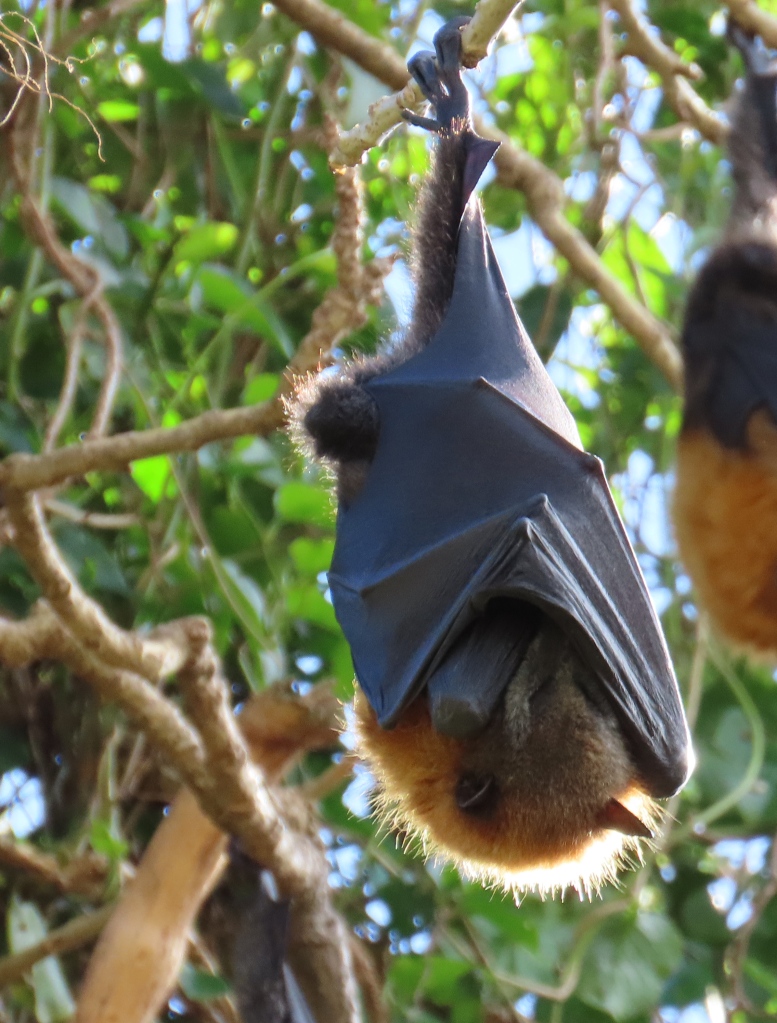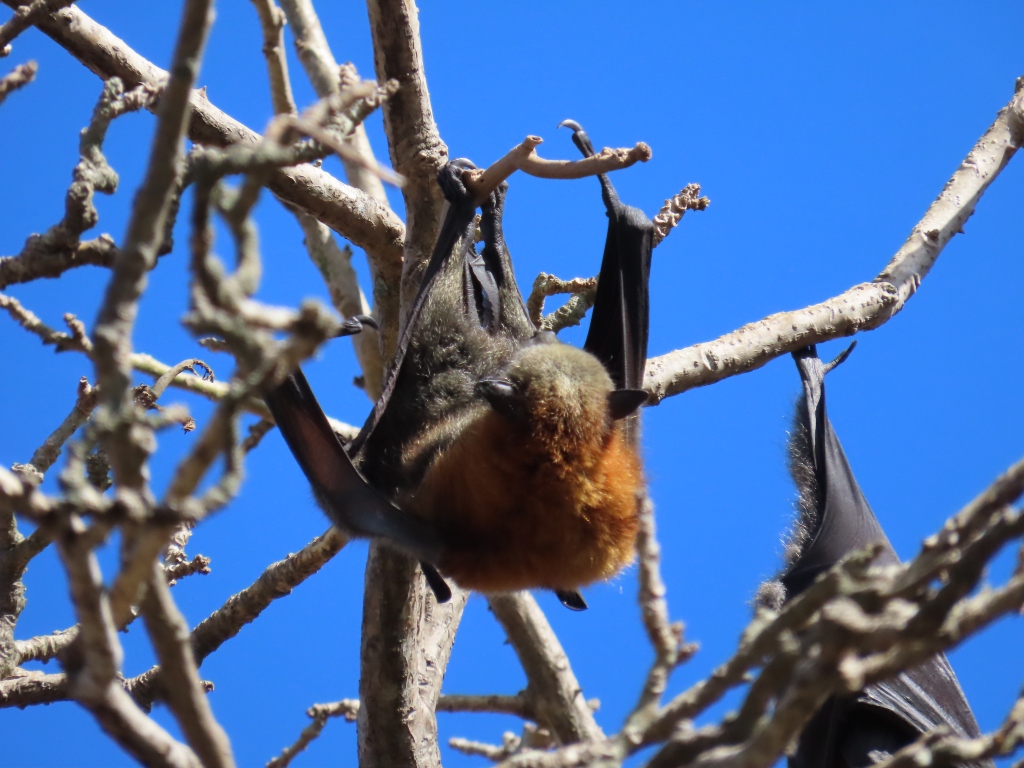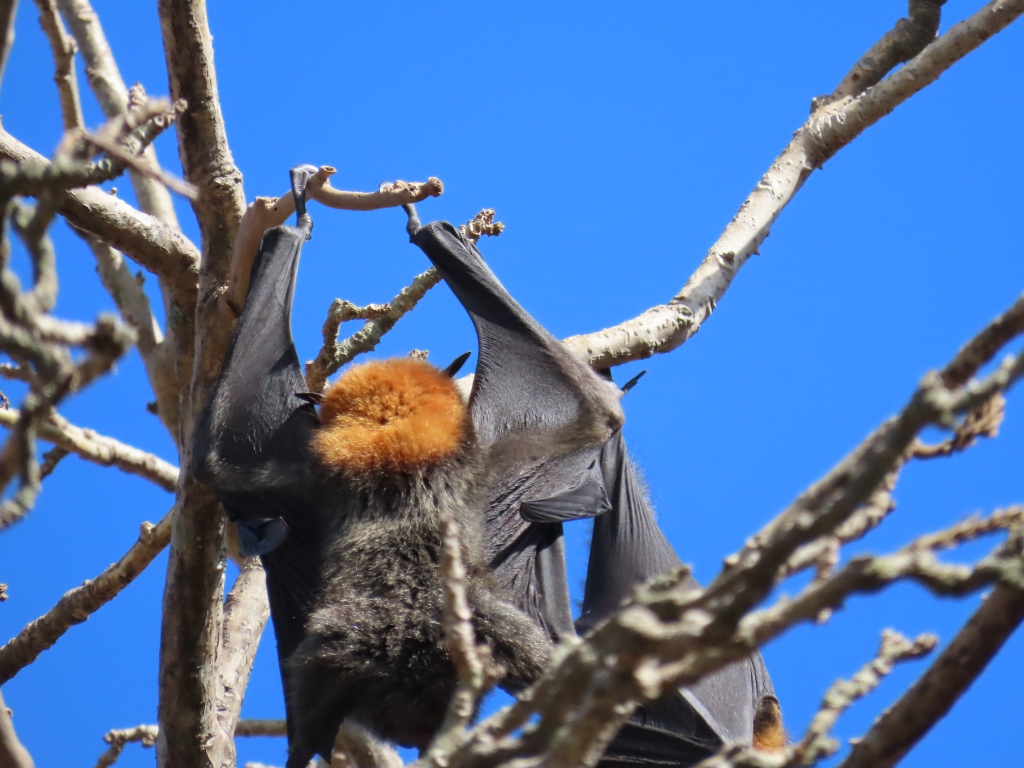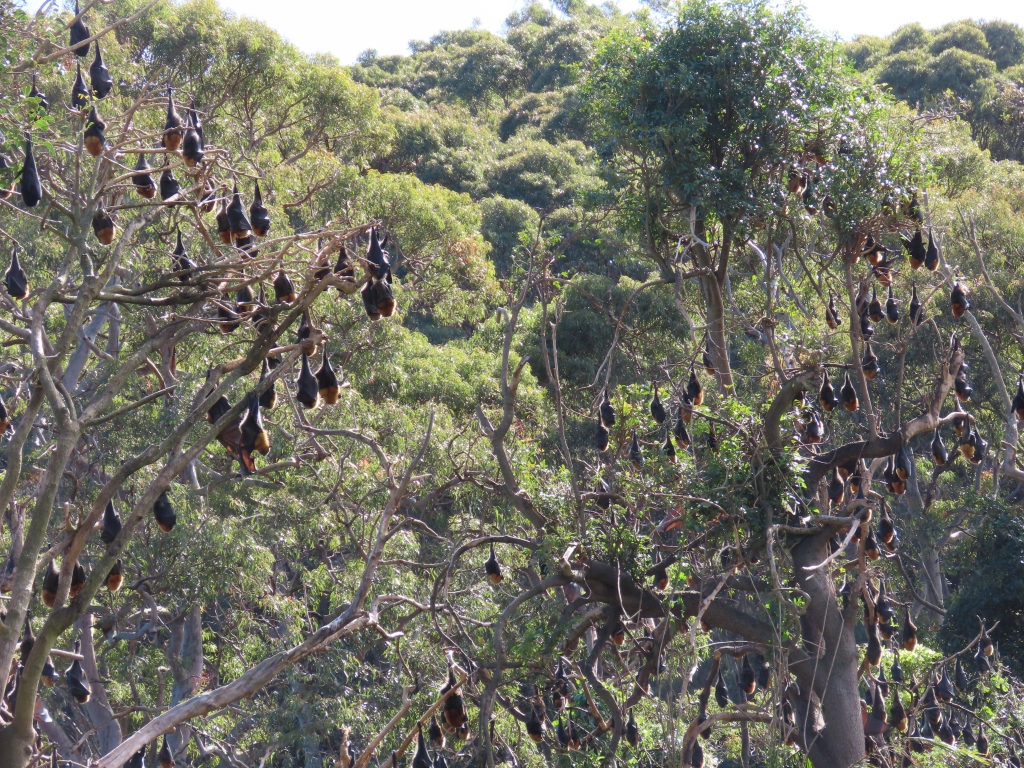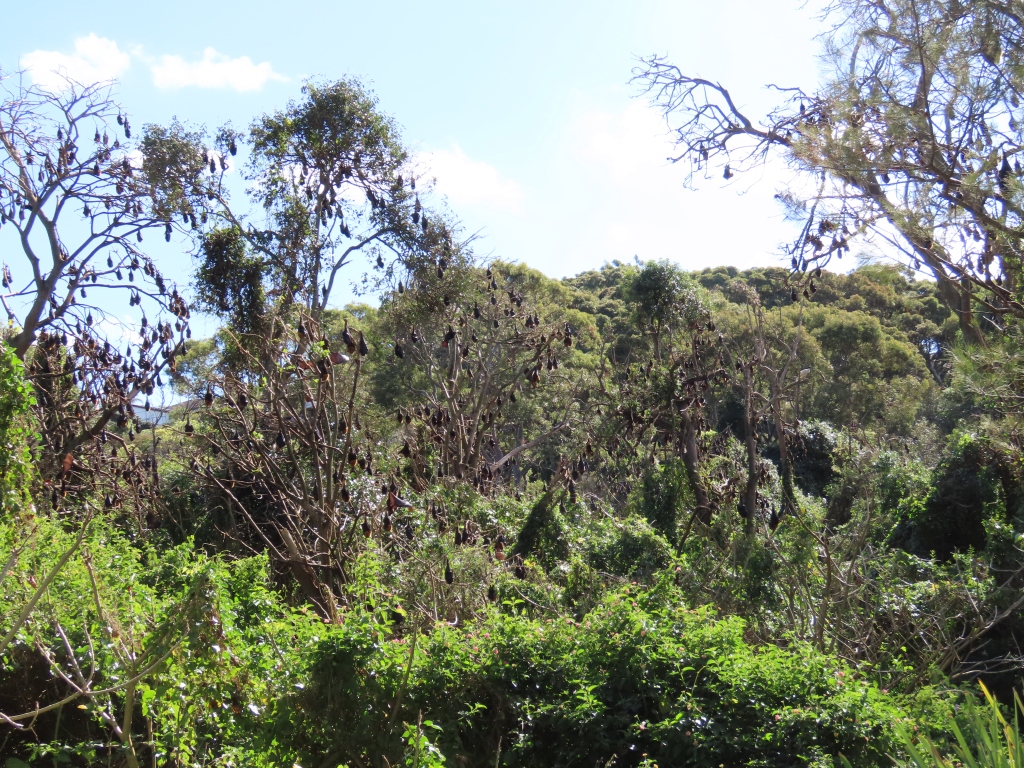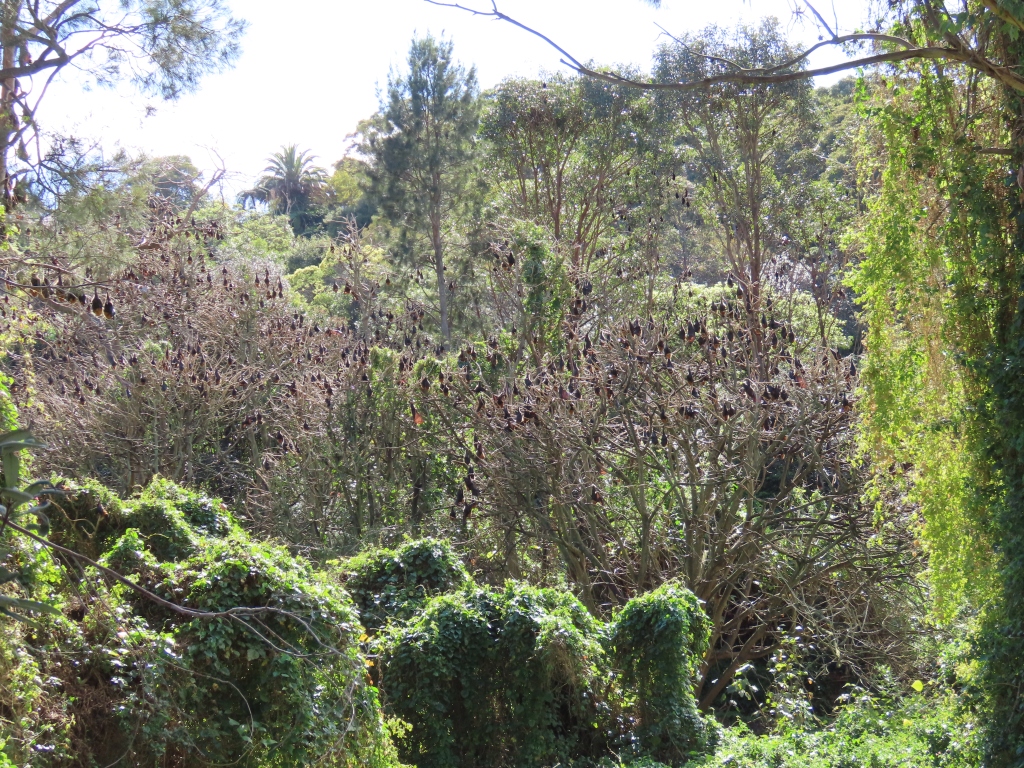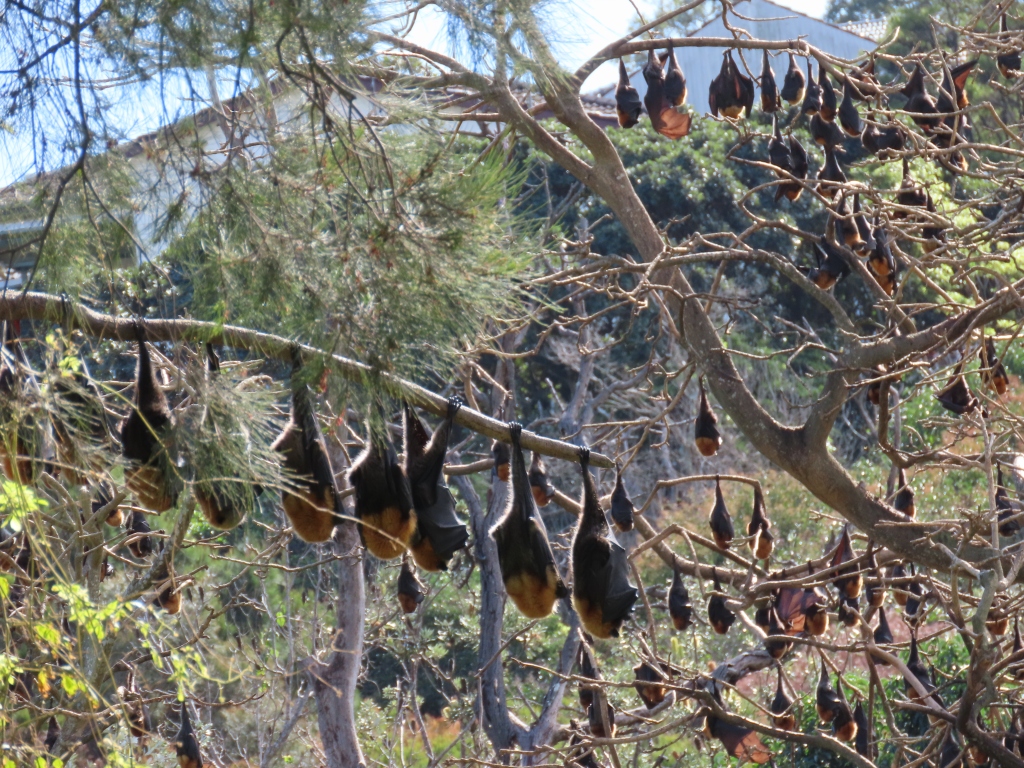Category Archives: Not a bird
Pretty but ew: Snail Parasitic Blowfly
I came across a large, pretty fly yesterday afternoon:
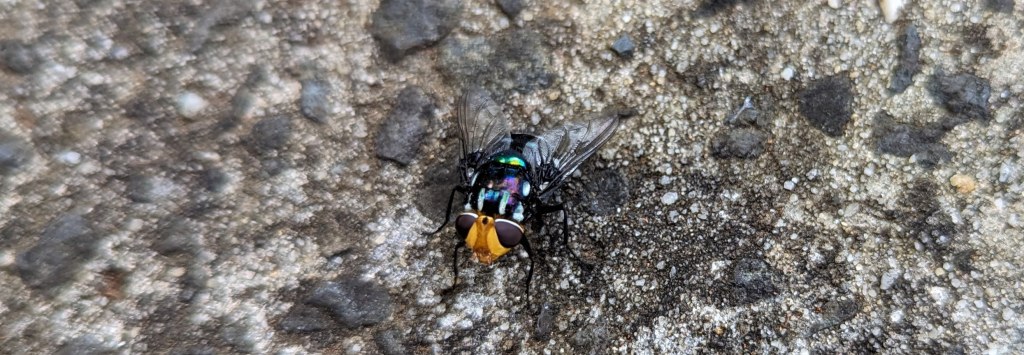
It’s a Snail Parasitic Blowfly (Amenia), found on the east coast of Australia. It has an orange head with large brown eyes outlined in white — almost as if it’s wearing sunglasses. Its body is mostly black, with turquoise, green, and purple patches and white spots. The wings are transparent.
Unlike other blowflies, this one doesn’t lay eggs or maggots in dead flesh. Instead, it lays its live larvae onto the shells of snails. The larvae then feed off the snail. The adult flies feed on nectar, helping to pollinate flowers.

There are many different types of blowfly, not all of them as pretty as this one. Evidently the name “blowfly” comes from Shakespearean times: when flies laid eggs on meat and maggots emerged, the meat was called “fly blown”.
Water Dragon lurking under water (mostly)
Australian Water Dragons (Intellagama lesueurii) are large dragon lizards, reaching a length of more than two metres. You’ll often spot them close to creeks and other bodies of water (hence the name, Water Dragon). Sometimes, you’ll see them actually in the water:
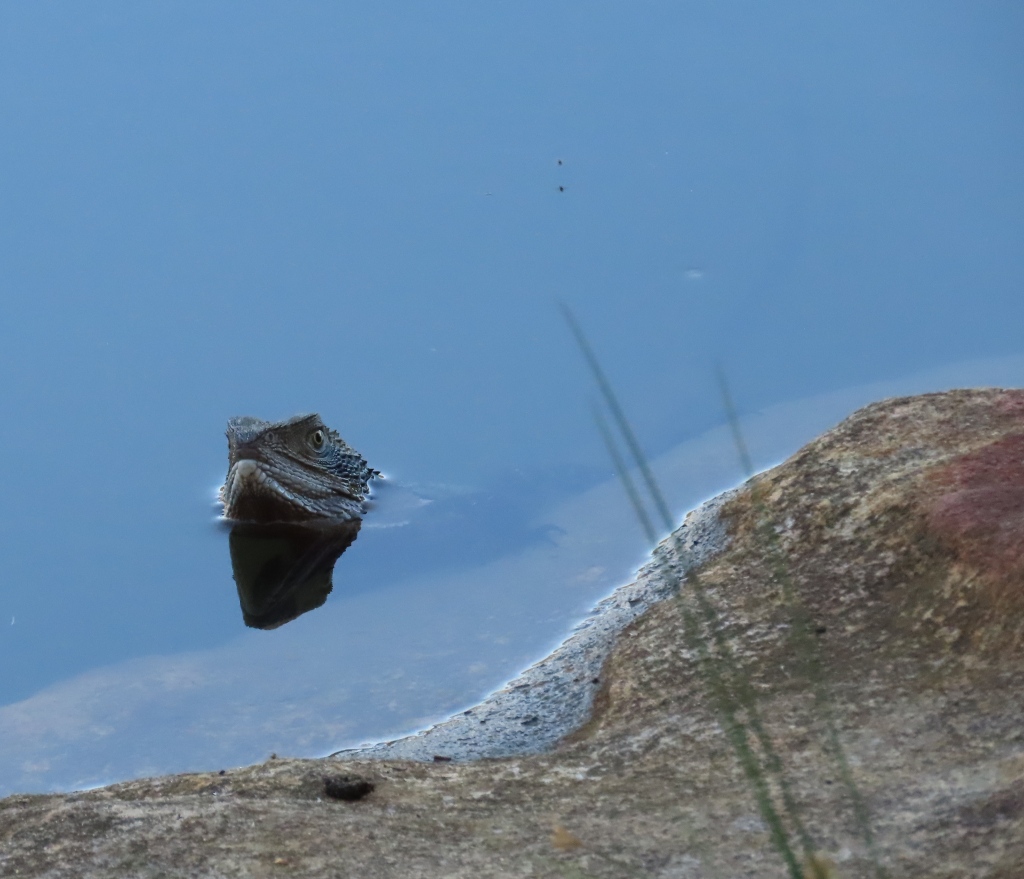
They can stay under water for an hour before coming up to breathe! From a distance, their heads are easy to mistake for a piece of log sticking up. As you draw closer, the rest of the body becomes clearer. This is a different dragon in a nearby spot:

They’re completely at home on the land too. When you approach them, they tend to stay still, pretending to be a tree stump, until you get too close.

Water Dragons eat insects, fruit, and flowers.
A few days ago, I came across a Water Dragon that had spotted a piece of litter (a wet tissue or picnic wipe) and was nosing it when I came along. The video shows the dragon’s characteristic side-to-side gait as it moves away from the litter. (I picked up the litter and took it away.)
Lace Monitor lizard at West Head Lookout
A Lace Monitor lizard was strolling around the West Head Lookout area in Ku-ring-gai Chase National Park when we visited this morning. We stood still as soon as we saw the lizard. It came quite close to us, then veered off when it noticed we were there.
Lace Monitors are the second largest lizard species in Australia, being up to 2 metres long. This one was quite small: about a metre long and quite slender.

Lace Monitors are good at climbing trees. They eat birds’ eggs, small birds in their nests, and other small creatures. They lay their eggs in termite hills, and they live about 20 years.
West Head Lookout gives gorgeous views across the Hawkesbury River and Pittwater waterways. In the distance is the Palm Beach peninsula with the Barrenjoey lighthouse on the headland at the end of the long strip of land. Beyond the peninsula is the South Pacific Ocean.

Neon Cuckoo Bee perched on its face
A cuckoo bee visited our garden today. I’ve only seen these bees a few times, and posted once before about them on this blog. That was way back in 2020, and the bee that came to visit on that day was black and white, a Domino Cuckoo Bee.
Today’s bee had blue markings, which I think makes it a Neon Cuckoo Bee (Thyreus nitidulus):
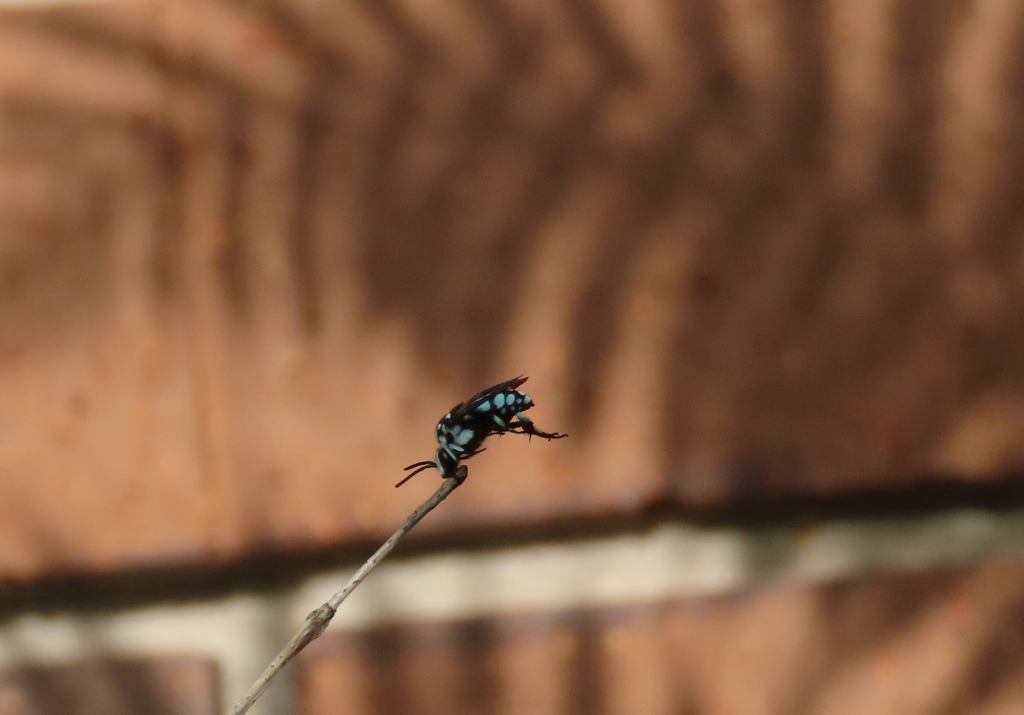
It looks as if the bee is resting on its face. In fact, it’s holding on to the twig with its mandibles — those are the strong jaw parts that it uses to chew its way out of its egg, shape wax into a honeycomb, feed its larvae, and more.
Cuckoo bees are native to Australia. They’re called “cuckoo bees” because they lay their eggs in other bees’ nests. In particular, Neon Cuckoo Bees target another Australian bee, the Blue-banded Bee. The Neon Cuckoo Bees’ eggs hatch more quickly than the host bee’s eggs, and the larva eats up all the nectar that the Blue-banded Bee parent has stored for its offspring!
Bubble birth
Raindrops falling from a tree into a puddle
Each one prompting the birth of a bubble
Background sounds: At the start of the video, a Masked Lapwing squawks in invisible indignation. A Suphur-crested Cockatoo continues the complaint. Noisy Miners warble their comments interspersed with scoldings. A Currawong carols a short reply.
A bubble reflects the branches that prompted its birth:

Wombat sick with mange (reported to WIRES)
A few days ago, we were in a remote region of New South Wales near the Abercrombie River National Park. We saw a sick wombat on the side of the road. It was clear that the animal was in a lot of pain, but we didn’t know what was wrong with it.
Here’s a picture of the wombat having a rest after walking up a small incline. (Note: There’s a video later in this post, which can be distressing to watch. However, it shows that the wombat has a lot of energy and is eating well.)
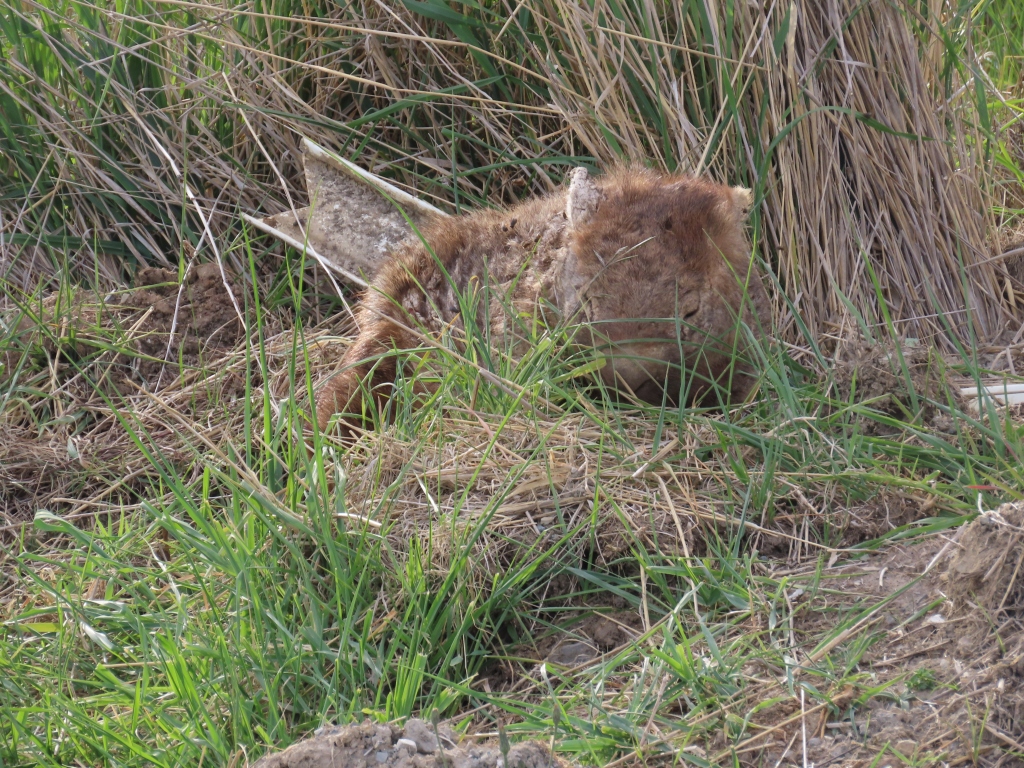
We passed the spot in the car, then turned round and went back to see if there was anything we could do to help. At first we thought maybe the animal had been hit by a car, because it was having obvious difficulty walking. It was eating well, which we took to be a good sign.
I didn’t get too close, because wombats are wild animals and deserve respect. The zoom on my camera was very useful in showing the animal’s condition.
I’d heard that a disease called mange is currently causing many wombats to fall ill, and I wondered if mange was the problem for this poor creature. But at that stage I didn’t know much about the condition.
We took some photos, then as soon as we had mobile service, we lodged an online report with WIRES, the Australian Wildlife Rescue Organization. We were able to give a Google Maps reference of the location of the animal. WIRES phoned us a couple of hours later, and confirmed the details. They then phoned us again the next day for further clarification, at which stage we were able to upload all our photos and the video too. A volunteer from nearby (that is, one and a half hours’ drive away!) would go out to look for the sick animal.
Mange is a skin disease, caused by tiny mites that burrow into the animal’s skin. It’s related to scabies in humans. One of the symptoms is the mass of flies attracted to the animal’s skin, which you can see if you magnify the photo in this post.
Evidently, treating a wombat with mange can be very successful. In most cases, treatment involves installing a flap on the entrance to wombat’s burrow and putting medication on the flap. The wombat thus gets dosed every time it enters and leaves home.
To compare this poor little wombat with a healthy one, take a look at the photos of a parent and baby wombat which we saw some distance away in Abercrombie River National Park.
Thank you and Kudos to Wires. Dealing with the people from WIRES was a very pleasant experience. I very much appreciate the hard work and dedication that the members of the organization and their network of volunteers put into rescuing wildlife in trouble.
Baby wombat in Abercrombie River National Park
In the lovely Abercrombie River National Park this weekend, I was lucky to come across a baby wombat and it’s parent on an early morning stroll. When I came on the scene, the parent nudged the baby towards a hole that led into its burrow. They stood there for a short time, then presumably decided I was safe enough, and continued their amble along the river bank.
Here they are in a lovely still photo. This was just after I saw them, and before I took the video. It looks as if the baby is emerging from another entrance to their burrow, though I didn’t go close enough to see:
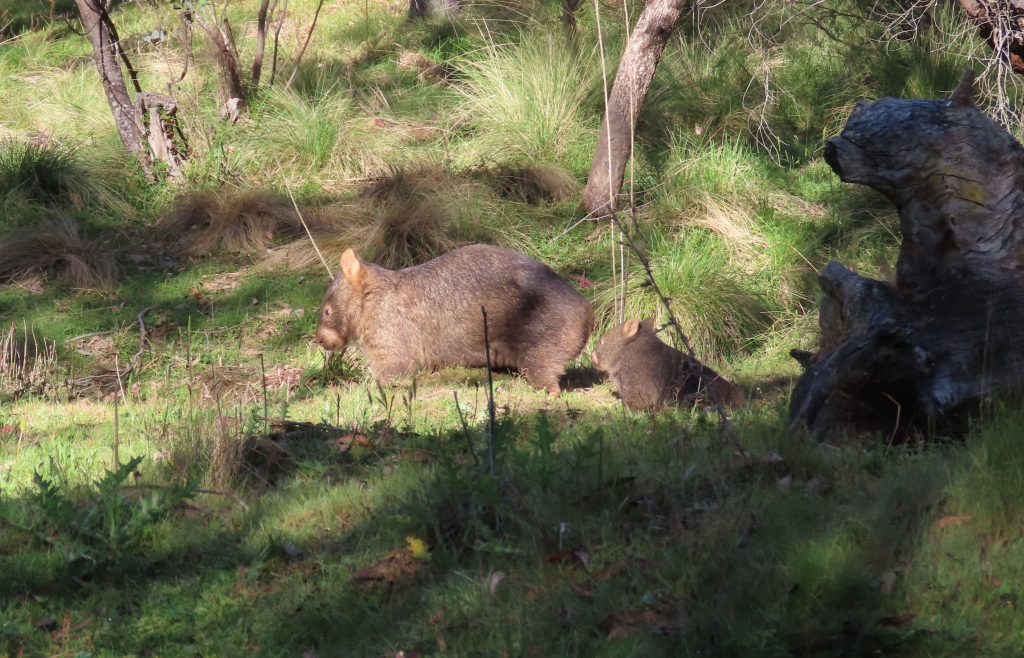
I count myself very lucky to have seen these animals, and such lovely healthy ones in such peaceful surroundings. Wombats are found only in Australia. Like many animals here, they’re marsupials. They’re also the koala’s closest relative.
They’re large, as far as burrowing animals go, at up to 1.3 metres in length and weighing more than 35 kilograms. They can also move very fast when they want to, although if you keep well away you’ll usually see them trundling along in a leisurely fashion like these two.
Spitfire grubs and Kookaburras
While wandering along a bush path, I came across a curious collection of grubs:
They’re spitfire grubs, which are the larvae of a type of wasp called a sawfly. The grubs look quite a lot like caterpillars with a don’t-mess-with-me attitude. They’re black and shiny, with white bristles, yellow feet, and a yellow tail. They’re quite long and fat: about the size of my little finger.
Despite the name “spitfire”, the grubs don’t actually spit anything, but if you touch them you can get a burning sting from the spikes. The grubs also spew out a thick yellow liquid from their mouths when threatened, but the liquid isn’t harmful to people. It’s made from eucalyptus oil, since the grubs feed on eucalyptus leaves.
In the video, you can see them tapping their tails on the rock. They do that to communicate their whereabouts with each other.
Here’s a close-up of some of their heads:
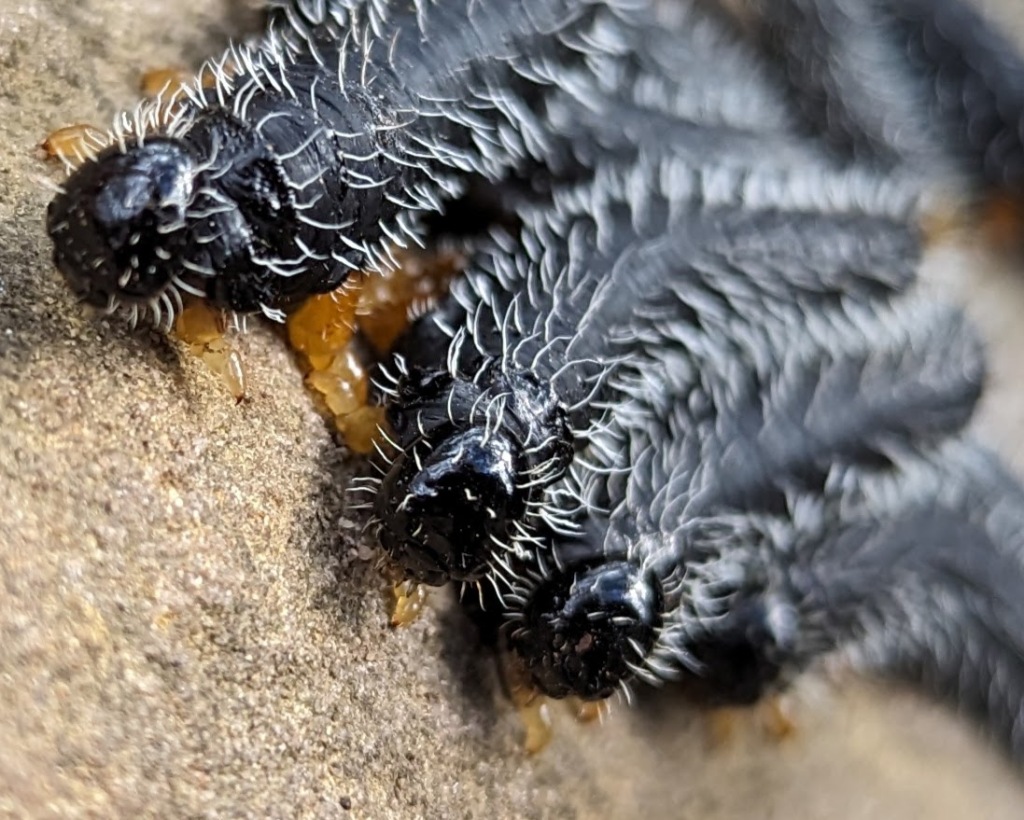
There were ten grubs in the clump:
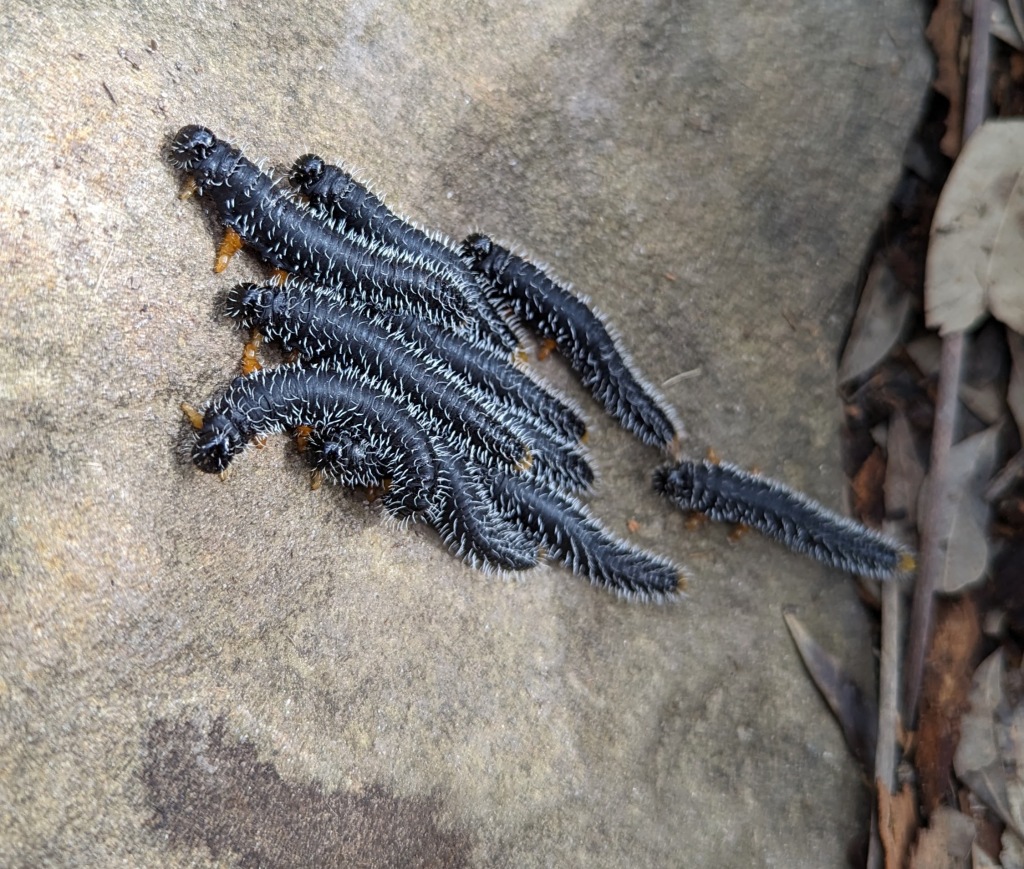
Next on the scene was a riot of Kookaburras! The birds gathered above me while I was bent over the clutch of spitfire grubs. I was worried that the Kookaburras might swoop down and grab a grub as a snack!
The Kookaburras left the grubs alone. I guess they don’t taste great!
Common name: Laughing Kookaburra
Scientific name: Dacelo novaeguineae
Approximate length: 47 cm
Date spotted: 18 July 2023 (winter)
Location: Manly Dam park, New South Wales, Australia: 33°46’56.0″S 151°15’05.4″E
Another gorgeous Red-bellied Black Snake
This was my third encounter with a Red-bellied Black Snake in three months! And that after never seeing one before.
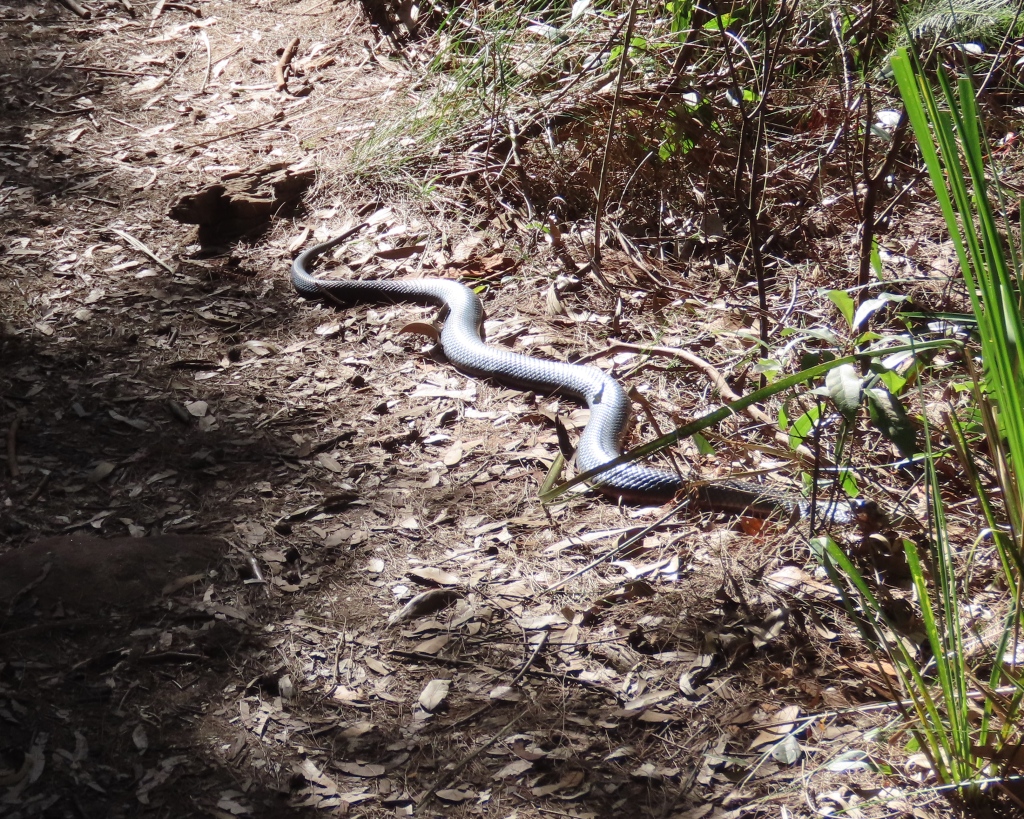
The snake was lying in the sun on the side of the walking track. I stopped to wait for it to move away. It was a big snake!
Red-bellied Black Snakes (Pseudechis porphyriacus) are quite large in comparison with other snakes I’ve seen. They’re a dark, shiny black on top, with a glowing red tinge underneath. You can see a bit of the red under-belly in this close-up of the snake’s head:
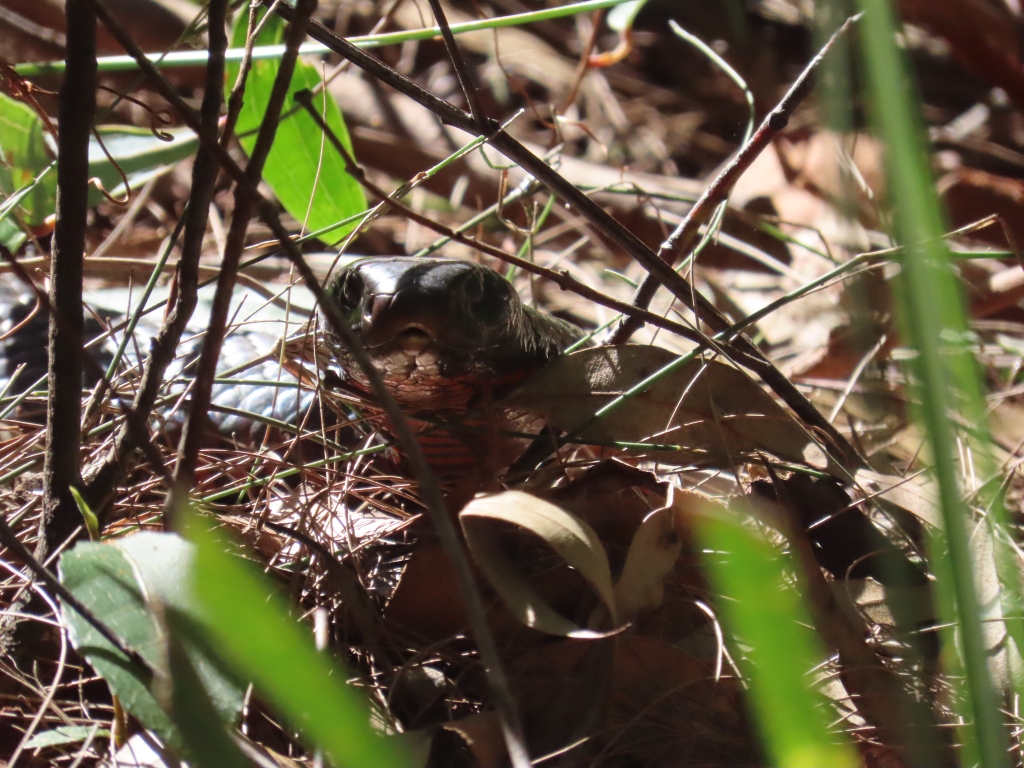
This snake was at Manly Dam (location on the map) where I often walk. My first encounter with a red belly happened near the Turon River, quite a way from my usual haunts. I posted a photo and video of that snake in another blog post. My second encounter was just a couple of weeks ago, a few hundred metres away from today’s snake at Manly Dam. It might have been the same snake.
Evidently the venom of Red-bellied Black Snakes isn’t as harmful to humans as some of the other snakes in these parts, but it can still make you quite ill. So it’s a good thing to give the snake its space. This one just watched me carefully. When I moved back, it slowly crossed the path in front of me and took shelter in the undergrowth. As I passed, I could see its head and flickering tongue as it watched me go.








